Find the Correct Saddle Size for Your Taylor® Guitar
Looking for a Taylor guitar saddle? Since 1974, Taylor has been making guitars, and there’s no single saddle that fits all guitar types, and this can make finding the correct saddle for your specific guitar difficult.
This article provides tips on finding the correct saddle for your Taylor guitar, but we suggest that you also measure your guitar’s saddle slot for a proper fit as every guitar is slightly different. If you are not the original owner, please note that at some time someone else might have installed a different saddle or have adjusted the saddle slot, producing different specs from the factory’s.
Please note that saddle specs listed within this article are either common saddle specs found on guitars, or the specs for a saddle if obtained directly from Taylor. Your guitar’s saddle specs will vary. The specs listed are common starting points, but not factory set heights that require no adjustment. Each guitar will have a slightly different neck angle, and so although the factory might adjust twelfth fret action to specified heights, technicians can achieve this through a combination of adjusting the neck relief, nut slot height, or saddle height, resulting in different saddle sizes for different guitars, even from the factory.
Step One: Determine Saddle Compensation Pattern
Steel String Saddles
There is no single compensation pattern used on Taylor steel string acoustic guitars, even for the same model. For example, a Taylor Mini from one year might have a different saddle from a Mini from another year. However, among the many saddle types used on Taylor steel string guitars, there are two common ones: Forward line B compensated or wave compensated. The two are not interchangeable and you must determine which type is on your guitar. Let’s review each.
Forward Line B Compensated

If your Taylor was built before 2011, then your guitar likely came from the factory with a forward line B compensated saddle. Please see our Guide to B Compensated Saddles for more information. These saddles are typically 72 mm long and 3.2 mm thick. Maximum height varies on each guitar, but is typically around 9 to 11 mm.
As shown in the below image, which shows a three degree saddle slot angle, this type of saddle puts all strings, except the B, to the front of the saddle, closer to the soundhole. The B string is compensated backward toward the bridge pins. The blue line shows approximately where each string sits.

Slanted Bass Wave Compensated – Steel String
Taylor’s wave saddle appeared on some models as early as 2010, then sporadically until 2013. During 2014 to 2015, both the forward line B compensated and slanted bass wave compensated saddles commonly appeared – read more at our Guide to Wave Compensated Saddles. After 2015, the wave compensated saddle has become much more common on Taylor models. These saddles are often made out of Micarta, but also made by Taylor in bone, at 71.5 mm long, 3.2 mm thick, with a maximum height that varies for each guitar, but is typically somewhere from 9 to 11 mm.
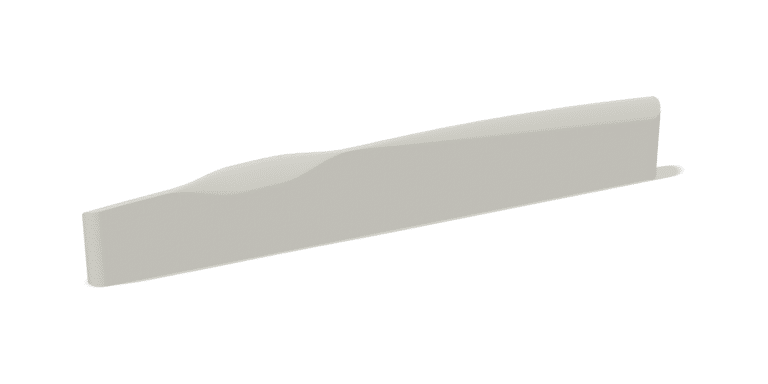
As shown in the below image, which is at a three degree saddle slot angle, the slanted bass wave compensation pattern will put the treble E and G strings forward, the D and A strings toward the center, and the B and bass E strings toward the back.

You might be tempted to replace your Taylor’s forward line B compensated saddle with a wave compensated saddle. However, we typically advise against this. First, the forward line B compensated saddle is 0.5 mm longer than the wave saddle is. Additionally, in deciding to use a specific saddle compensation pattern, a guitar builder will factor in a model’s saddle angle, scale length, string spacing, string gauge, and other factors. Replacing a forward line B compensated saddle with a wave compensated saddle could have a negative impact on your intonation, particularly if your string spacing does not match the saddle compensation pattern.
Center Line Non-Compensated
Some Taylor guitars built before 2000 will have a center line non-compensated saddle, although this is quite rare and more common among models from the 1970s or 1980s. Please see our Guide to Non-Compensated Saddles for more information.
Twelve String Saddles
Depending on the year and model of your Taylor twelve string, it might have one of the saddles listed above. More recently, though, Taylor has used specific saddles for a number of twelve string models as discussed below.
First, let’s look at Taylor’s double compensated saddles. A double compensated saddle will have compensation for both the standard and octave strings. Taylor offers two versions – one for acoustics and one for T5 twelve strings.
Double Compensated for Twelve String Acoustic
Taylor offers the Double Compensated Saddle for Twelve String Acoustics in bone or Micarta. Specs: Length: 71.1 mm. Max height: 9.75mm. Bass/Treble edge height difference: 1.8 mm. Thickness: 3.2 mm. Radius: 15 inches.
Double Compensated for T5 Twelve String
Taylor offers the Double Compensated Saddle for T5 Twelve String only in bone. This is a thick saddle at 4.1 mm and also has a 12 inch radius. This saddle is also a routed front saddle, which looks like a center line non-compensated saddle from the back, yet has the compensation routed on the front. Specs: Length: 71 mm. Max height: 9.75 mm. Bass/Treble edge height difference 1.7 mm. Thickness: 4.1 mm. Radius: 12 inches.
String Slotted Saddle
Now let’s look at Taylor’s string slotted saddle, which is made for reverse strung twelve strings. A string slotted saddle has slots on the saddle for the strings, somewhat similar to string slots on a nut. Normally you will not find slots on saddles, and if you do, those were likely a result of the string pressure slowly gouging the slots, not intentionally made slots. String pressure is typically sufficient to keep strings in place at the saddle, but for this particular saddle, Taylor has chosen to slot the saddles. No other Taylor saddles are slotted.
A reverse-strung twelve string guitar is set up so that the fundamental string is on top and the octave strings on bottom. Taylor will often use only six bridge pins with this set up.
Taylor offers a String Slotted Saddle for reverse-strung twelve strings. Specs: Length: 71mm. Max height: 10.1 mm. Bass/Treble edge height difference: 1.8 mm. Thickness: 3.2mm. Radius: 15 inches.
T5 Saddles
Taylor offers four different saddles for T5 models. Please see the above section for a discussion of the T5 twelve string saddle. Below is a description of each of the three T5 six string saddles used. Please measure your guitar’s current saddle to determine which is needed.
Routed Front Acoustic
A routed front saddle looks like a center line non-compensated saddle from the back, yet has compensation routed on the front. Please see our Guide to Routed Front Guitar Saddles for more information.
The T5 “acoustic” version is compensated for use with a set up of four wound strings (E, A, D, G) and two plain strings (B, e). This is a thick saddle at 4.1 mm. Specs: Length: 71 mm. Maximum Height: 9.725 mm. Bass/Treble edge height difference: 1.7 mm. Thickness: 4.1 mm. Radius: 12 inches.
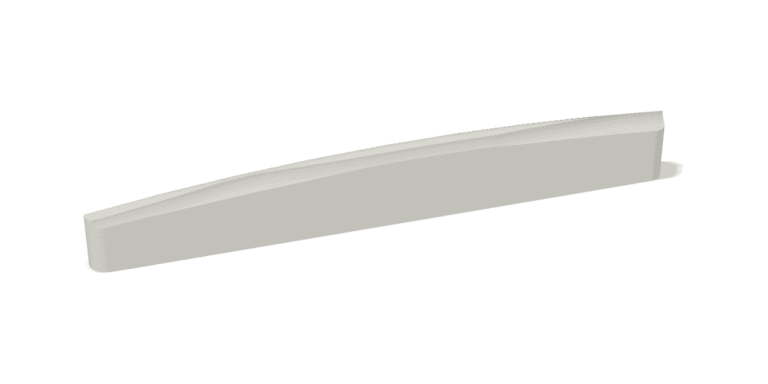
As shown in the below image, which is at a three degree saddle slot angle, the routed front “acoustic” style compensation pattern places the treble E, G, and D strings forward, B and A strings toward the center, and the bass E string toward the back.

Routed Front Electric
At first glance, the “acoustic” and “electric” T5 routed front saddles might seem the same. However, the T5 “electric” version is compensated for a set up of three wound strings (E, A, D) and three plain strings (G, B, e), similar to what you would find on an electric guitar – see our article on Acoustic Guitar Saddles for Plain G String Set Up for more information. This is a thick saddle at 4.1 mm and not interchangeable with the B and G Compensated saddle mentioned in the next section. Specs: Length: 71 mm. Maximum Height: 9 mm. Bass/Treble edge height difference: 1.5 mm. Thickness: 4.1 mm. Radius: 12 inches.
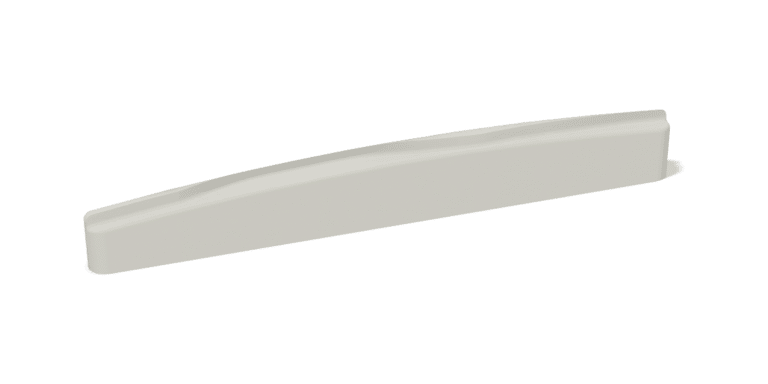
As shown in the below image, which is at a three degree saddle slot angle, the routed front “electric” style compensation pattern will put the treble E, B, D, and A strings toward the center, and the G and bass E strings toward the back.

B and G Compensated
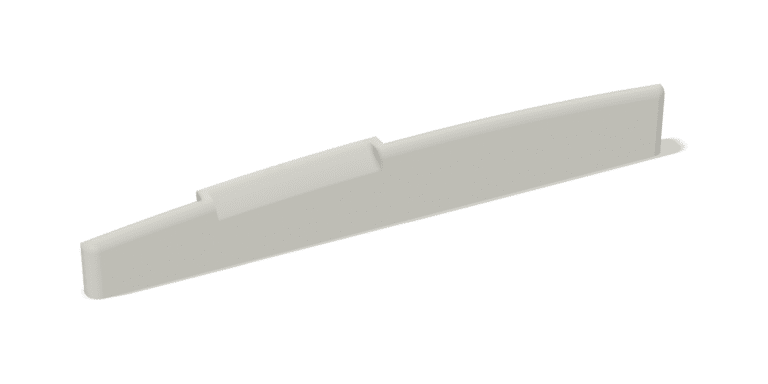
Similar to the Routed Front Electric saddle, the B and G compensated saddle is designed for use with a set up of three wound strings (E, A, D) and three plain strings (G, B, e). See GraphTech PQ-9201-CO. Specs: Length: 71.2 mm. Maximum Height: 10 mm. Bass/Treble edge height difference: 2.15 mm. Thickness: 3.2 mm. Radius: 12 inches. For a similar option in bone, please see our Compensated B and G Bone Saddle.
Nylon String Saddles
Similar to steel-string saddles, Taylor’s nylon string guitar saddles will vary significantly and we advise that you measure your current saddle, bridgle saddle slot, and fretboard radius before ordering a replacement saddle. However, below are two somewhat common saddle types for Taylor nylon string models.
NS Wave Saddle
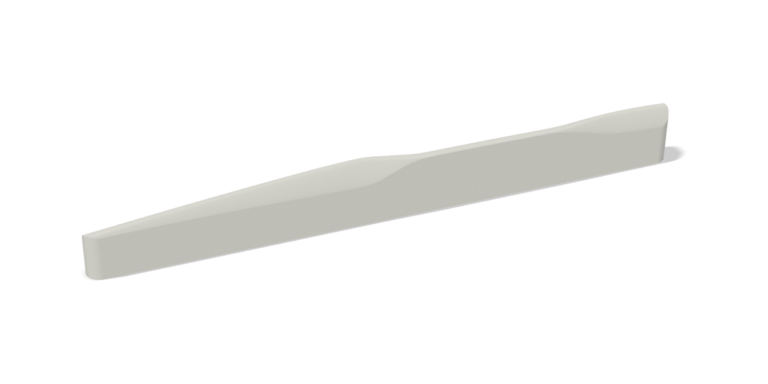
As shown in the below image, which is at a one degree saddle slot angle, this saddle compensation pattern will put the treble E, D, and A strings forward, the B and bass E toward the center, and the G string toward the back.

Taylor’s NS Wave Saddle is designed for nylon string models. At first glance it might seem similar to the steel-string slanted bass wave saddle, but the NS saddle puts the treble E string forward, B string in the center, G string at the back, D and A strings forward, and bass E string back. Specs: Length: 71 mm. Maximum Height: 7.4 mm. Bass/Treble edge height difference: 1.2 mm. Thickness: 3.2 mm. Radius: 20 inches. Available from Taylor in Micarta in right- or left-handed. Please see our NS Saddle – Fits Some Taylor Nylon String Guitars for an option in bone.
Center Line A Compensated
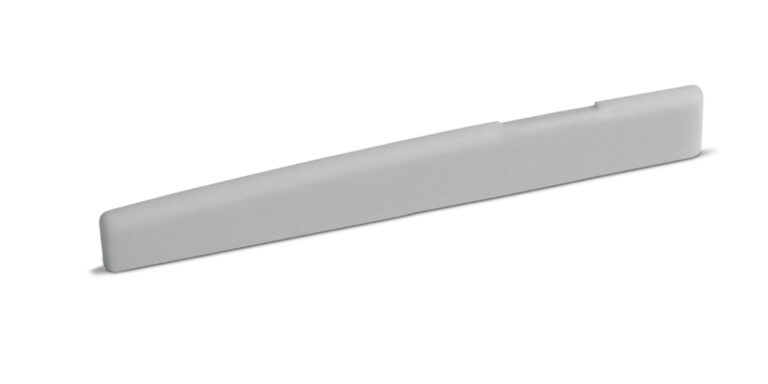
Some Taylor nylon string guitars will have a center line A compensated saddle. This saddle type is essentially a center line non-compensated saddle, but with the A compensated forward. Specs: Length: 72 mm. Maximum Height: 10 mm. Bass/Treble edge height difference: 1.2 mm. Thickness: 3.2 mm. Radius: 20 inches. Please see our Center Line A Compensated Saddle for options in bone.
Step Two: Determine Fretboard Radius
If your Taylor was built before 1990, then measuring your fretboard radius is crucial before purchasing a saddle. If made after 1990, a steel-string Taylor likely has a 15 inch fretboard radius, but we still advise that you measure. Exceptions include T5 models, which typically have a 12 inch radius, and nylon string models, which often have a 20 inch radius. We always advise confirming your guitar’s fretboard radius before purchasing a saddle. You can either contact Taylor with your serial number or print out radius gauges.
Step Three: Determine Length and Thickness
Taylor saddles are typically 71 to 72 mm long, with thickness typically either 3.2 mm or 4.1 mm. We advise that you measure your current saddle and your saddle slot as subtle differences appear. We’ve received reports of Taylor saddles being as short as 70 mm and as long as 75 mm. If you’re not the original owner, then someone may have adjusted the saddle slot and inserted a different saddle size.
Step Four: Determine Maximum Height and Bass/Treble Edge Height Difference
Maximum saddle height will vary for each guitar, even from the factory. Additonally, acoustic guitar saddles often have a taller bass side height than the treble for increased action height for the thick, wound bass strings. This height difference will vary for each guitar, even from the factory. For Taylor guitars, this is often around 1.5 to 2 mm. Please see our article on How to Adjust Saddle Height on One Side More than the Other for more information.
Step Five: Determine Material
Taylor typically uses Tusq, Micarta, or bone for saddles. There is no best material as each will produce different tonal characters. For more information on these materials and how they compare, please see our article on Acoustic Guitar Saddle Materials.
Which Saddle Does Your Taylor Need?
Still wondering which saddle your Taylor guitar needs? Please contact us with all of the below information.
- Fretboard Radius
- Current Saddle Length, Maximum Height, Thickness – Must be measured with a caliper
- Bass to Treble Edge Height Difference
- Guitar Saddle Slot Length, Thickness (if different from saddle specs) – Must be meausured with a caliper
- Guitar string spacing at the bridge
- Current Saddle Compensation Pattern (Please send a picture if you are not sure which type you have)
We will respond within 48 hours.
